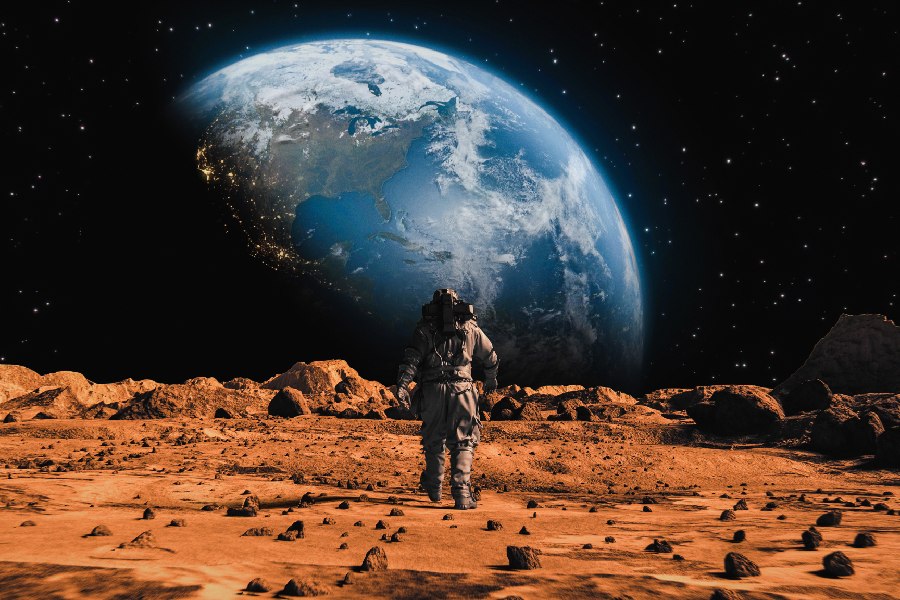The Red Planet, Mars, is the second closest planet to the Earth. But how long does it take to get to Mars with our current technology? NASA, SpaceX, and other space organizations are actively working to enable faster crewed missions to reach and eventually colonize Mars.
This question intrigues both space enthusiasts and scientists alike as missions continue being launched to explore the Red Planet. Though Mars remains relatively close in astronomical terms, spanning the distance still requires an extended time commitment beyond most other travel destinations.
This article will analyze the basics behind planning a journey to reach Mars. We will also look at the factors affecting the duration of this celestial voyage. Several factors influence trip time, such as launch windows, orbital trajectories, and propulsion systems.
You may be surprised at the trade-offs necessary for balancing travel duration versus payload mass and optimal energy expenditure. Read on to discover how long would it take to travel to Mars. The complex answer remains rooted in the pioneering spirit of interplanetary exploration.
How Long Does It Take to Get to Mars?
How long does it take to get to Mars? The journey takes about seven to nine months. However, this duration is influenced by the spacecraft’s speed and the alignment of Earth and Mars in their orbits, as the distance between the two planets varies.
Spacecraft are launched during optimal planetary alignment for efficiency. Upon arrival, Mars missions may involve extended stays on the planet’s surface.
The specific travel time to Mars can vary based on the mission’s objectives and the technology used for space travel. For example, more advanced propulsion systems can shorten the trip.

Orbital Dynamics
Earth and Mars orbits
The reason it takes so long to reach Mars is because Earth and Mars have very different orbits around the Sun. Earth orbits at an average distance of 93 million miles from the Sun. Mars, on the other hand, orbits much farther from the Sun at an average of 142 million miles away. So, how far is Mars from Earth?
The distance between Earth and Mars changes a lot over time. The planets are closest when Mars lines up on the same side of the Sun as Earth at around 37 million miles apart. But when on opposite sides from each other, the gap widens to over 250 million miles.
Spacecraft must wait for an alignment that brings Earth and Mars at their shortest distance before launching. Even then, they cannot travel straight to Mars. Instead, NASA engineers plan a special orbit called a Hohmann transfer orbit to efficiently bridge between Earth’s and Mars’s very different paths circling the Sun.
Hohmann transfer orbit
The Hohmann transfer orbit provides the most common route for sending spacecraft from Earth orbits to reach Mars orbit. This elliptical orbit is calculated to touch at the two different tracks of Earth and Mars as they orbit the Sun.
Spacecraft are launched into a specialized oval transfer orbit that allows them to intercept Mars as both planets progress in their natural Sun-centered orbits. This transfer orbit enables the spacecraft to rendezvous with Mars when the alignment of the two planets is optimal.
Using this technique requires the least amount of propulsion energy from the spacecraft. However, even using this energy-efficient transfer orbit, the trip still takes six to nine months.
The exact duration depends on where Earth and Mars are in their orbital paths during the launch year, impacting the distance and alignment required for an optimal rendezvous point.
Launch Windows
Definition and significance
Launch windows describe the best timeframe for launching a rocket to successfully reach its destination. Launch windows are important for Mars because the planets travel differently around the Sun.
Spacecraft can only launch when Earth and Mars line up at the shortest distance apart during their orbital cycles. Otherwise, the gap is too large. Aligning a launch in the narrow window when Earth and Mars converge is key.
It minimizes the distance for rockets to cover and sets up the correct alignment to enter a fuel-efficient Hohmann transfer orbit to chase Mars as the planets continue orbiting the Sun. Missing the launch window could result in mission cancellation or extremely long multi-year travel times.
Opportunities for optimal alignment
The launch windows to Mars come around predictably, thanks to the orbital patterns of the planets. Mars takes roughly twice as long to orbit the Sun compared to Earth – about two years versus one year.
So, most optimal alignments have a 26-month cycle. Approximately every two years and two months, Earth lines up with the point Mars has reached in its orbit to offer an efficient trajectory. This helps navigate launch windows and define mission duration possibilities years in advance.
Shortest and Longest Distances
Perihelic and aphelic oppositions
Earth and Mars do not orbit the Sun in perfect circles – instead, they follow stretched-out oval shapes known as ellipses. Mars’s distance from the Sun varies even more than Earth’s. When closest to the Sun, Mars is in perihelion. When farthest from the Sun along its orbit, Mars is at aphelion.
Depending on whether Earth or Mars lies at perihelion or aphelion during their alignment, the gap between planets can shorten or lengthen significantly. If alignment coincides with Mars’s perihelion and Earth’s aphelion, the distance shrinks.
If, instead, Earth reaches perihelion while Mars is at aphelion, the gap widens by tens of millions of miles – increasing transit times drastically. Where the planets sit in their eccentric orbits during opposition impacts if it becomes a “close approach” year or a more distant opposition.
Shortest and longest distance scenarios
The shortest trip using optimal alignments and orbits is around six months. This relies on close perihelic opposition timing when the Earth-Mars distance drops under 60 million miles. Over 30% shorter than average oppositions near 100 million mile gaps.
Peak alignments can enable fewer mid-course corrections and faster transit utilizing less propellant. On the flip side, ill-timed aphelic oppositions combined with suboptimal orbits can nearly double one-way travel times.
Missions launched in these outlier years must carry extra fuel if accelerating faster or budget over double the supplies for astronauts if coasting longer in slower transits spanning 13-14 months one-way. Both scenarios pose engineering challenges current technology strives to mitigate.

Calculating Hohmann Transfer Orbit for Fastest Travel Time to Mars
Planning the optimal Mars trajectory
The route enabling the fastest journeys to Mars utilizes a finely calibrated transfer orbit known as the Hohmann transfer orbit. Engineers determine the precise trajectory by pinpointing when Earth and Mars are aligned closest together in their solar orbits during a launch window.
They identify the specific positions of both planets down to precise latitudes, longitudes, and distances from the Sun. Plugging the planetary alignment details into mathematical formulas plots the most efficient lowest energy path to catapult between their orbits. It defines an oval-shaped elliptical orbit that just touches Earth and Mars orbits on opposite ends.
Executing the precise spacecraft maneuvers
By entering this calculated orbit, spacecraft can chase Mars down utilizing the least amount of thruster propellant and the shortest overall travel distance. Fine-tuning the Hohmann transfer orbit utilizes physics and calculus to pave the fastest highway through the solar system for crafts to surf between worlds.
Executing the transfer at precisely the right spacecraft velocities when leaving Earth orbit and arriving in Mars orbit is critical. Achieving accuracy within a narrow velocity range for injection and arrival helps crafts smoothly shift onto Mars’ orbital highway.
Following the principles behind the Hohmann transfer, orbit offers the fastest route to Mars. This fast route would benefit future astronauts aiming to minimize prolonged exposure to microgravity and radiation hazards during ambitious Mars missions.
Speed of Travel
Required speed
Traveling from Earth orbit to Mars requires spacecraft to reach great speeds over 25,000 mph. This allows them to escape Earth’s gravity onto a path intersecting Mars’ orbit when aligned.
While rockets do boost to these high speeds, they cannot maintain full throttle the whole trip. Carrying that much fuel over millions of miles is not practical. Instead, rockets coast for most of the journey after the initial blastoff acceleration.
Fine-tuned trajectories utilizing orbital mechanics enable crafts to achieve brisk Mars transit velocity efficiently. Following the calculated Hohmann transfer orbit principles locks ships into the speed and path to Mars.
This path carries them the distance to Mars in minimum time. Riding this orbital highway carved through the heavens, ships sprint across the 50 to 400-million-mile marathon to the Red Planet.
Current Technology Used on Missions to Mars
Technological aspects
Sending humans to Mars requires specialized vehicles and equipment. Rockets carry cargo across space, combining powerful thrusters with lightweight materials.
NASA’s Space Launch System aims to launch soon with the largest capacity to send payloads beyond Earth orbit. Propulsion technology strives to produce maximum energy efficiently from high-tech fuels and engines.
Critical surface survival systems
Specialized components enable survival in the harsh Martian environment, which lacks air, heat, and supplies from Earth. During atmospheric entry, launch vehicles employ advanced heat shields to protect spacecraft against searing temperatures that can reach nearly 3,000°F.
Before astronauts arrive, robotic systems are deployed to assemble habitats on the Martian surface. Once crews land, self-contained life support systems continuously filter air and water to sustain them throughout their surface operations.
Overcoming deep space hazards
Radiation challenges also drive innovations in shelter designs using water walls, polyethylene plastics, and Martian soil resources.
Bioastronautics researchers study the risks associated with extended exposure to microgravity and seek solutions to maintain astronauts’ health during multi-year interplanetary journeys in isolation.
These missions face extreme settings light-years from home. However, through the continuous development of specialized technologies, ambitious endeavors edge closer to charting humankind’s farthest frontier.
Conclusion
Traversing the expanse to reach Mars proves an inherently lengthy endeavor spanning up to nine months or longer each way due to the sheer scale and distance involved. We hope you now have better clarity on the elegant orbital dance that makes interplanetary trajectories possible every 26 months when planets align closest.
This article has elucidated key variables from launch windows to efficient Hohmann transfers to technological considerations all influencing mission duration. How long does it take to get to Mars?
Though one-way transits continue shrinking towards just 3-4 months as propulsion improves, it’s possible that future generations will view these long travel times as merely early growing pains.
For now, the months-long odyssey to Mars highlights the challenges of interplanetary travel while also representing tremendous progress. With continuous innovation, what once seemed an impossible feat is gradually becoming a reality.
